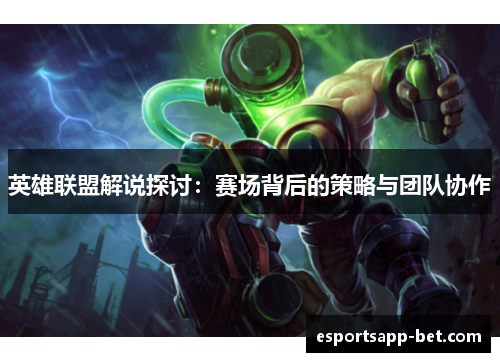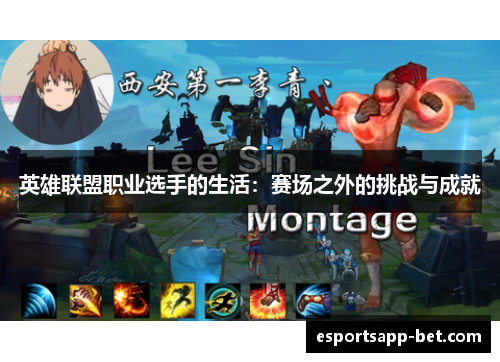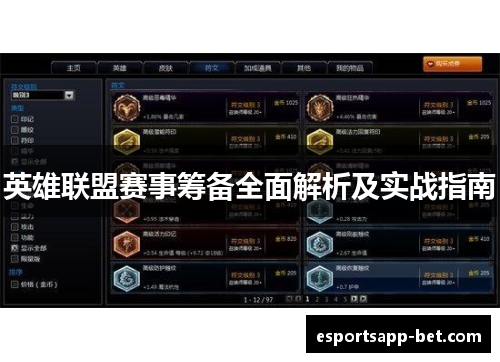英雄联盟解说探讨:赛场背后的策略与团队协作
Certainly! Here's the structured article as per your requirements:

**Abstract:**
In the world of League of Legends casting, exploring the strategies and team dynamics behind the scenes reveals a complex web of decision-making and coordination. This article delves into four key aspects: drafting strategies, early game tactics, mid-game rotations, and late-game shotcalling. Each section uncovers how teams strategize, communicate, and adapt to secure victory on the Summoner's Rift.
1、Drafting Strategies
Team composition in League of Legends starts long before champions enter the Rift. Drafting strategies encompass meticulous planning, counterpicks, and prioritization based on meta trends and individual player strengths. The first phase of drafting involves scouting opponents' tendencies and formulating a plan to secure key champions while denying crucial picks. Teams must balance comfort picks with strategic versatility, aiming to build synergistic compositions that capitalize on their strengths while exploiting enemy weaknesses.
Once draft phase begins, communication among coaches and players becomes paramount. Drafting is not merely about individual preferences but aligning team objectives with strategic flexibility. Adaptability is key, as last-minute adjustments can often decide the outcome of a match.
Moreover, drafting extends beyond champion selection; it encompasses predicting opponent rotations and objective priorities. This strategic foresight sets the foundation for early-game execution and mid-game dominance.
2、Early Game Tactics
The early game sets the pace and tone for the entire match. Teams execute their early-game tactics based on the drafted compositions and initial jungle pathing. Lane swaps, aggressive jungle invades, and vision control define the first 15 minutes, where each decision impacts subsequent phases significantly.
Effective communication during the early game is crucial for coordinating ganks, securing objectives like the first dragon or Rift Herald, and establishing lane dominance. Shotcalling in this phase revolves around creating advantageous trades, tracking enemy cooldowns, and capitalizing on positional errors.
Strategic use of teleport spells and summoner spells further amplifies early-game impact, as teams seek to gain incremental advantages that snowball into mid-game control.
3、Mid-Game Rotations
The mid-game transitions focus on rotational play and objective control. Teams pivot from laning phase advantages to securing outer turrets, controlling vision around major objectives like Dragon and Baron, and executing coordinated rotations to catch opponents off-guard.
Shotcalling becomes more dynamic in the mid-game, with teams balancing split-pushing strategies, skirmishes, and teamfight engagements. Vision denial and jungle control emerge as critical elements, influencing the map's tempo and enabling proactive plays.
Strategic shotcalling in the mid-game hinges on efficient resource allocation and map pressure. Teams often opt for lane assignments that maximize gold income and experience while maintaining map presence for decisive teamfight engagements.
Successful mid-game shotcalling requires adaptability and foresight, as teams navigate around enemy vision and positional advantages to secure pivotal objectives and maintain map control.
4、Late-Game Shotcalling
The late-game phase revolves around high-stakes teamfights and objective contests that can swing the match's outcome. Shotcalling in this phase shifts towards identifying win conditions, coordinating around major buffs like Baron and Elder Dragon, and executing decisive engages or disengages.
Teams rely on vision denial and strategic positioning to create favorable teamfight scenarios. Shotcallers must balance aggression with caution, leveraging accumulated advantages to secure game-ending objectives or punishing opponents' positional errors.
Late-game shotcalling often requires split-second decision-making and clear communication under pressure. Teams must maintain composure and adapt their strategies based on real-time information and enemy movements.
总结:
竞猜平台英雄联盟解说揭示了赛场背后复杂的策略和团队协作。从精确的选人策略到动态的比赛进程管理,每个阶段都需要团队间的高效沟通和战术调整。优秀的团队不仅仅依赖个人技能,还要依靠集体智慧和战术执行力。通过深入分析,可以看出团队如何在紧张的比赛中迅速适应和反应,从而赢得胜利。
总结内容第一自然段
总结内容第二自然段

